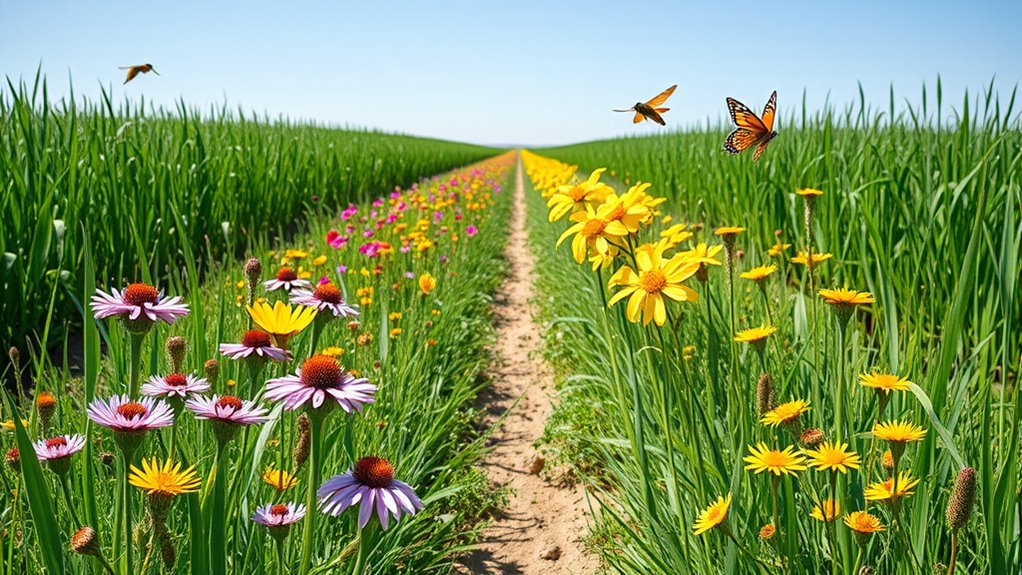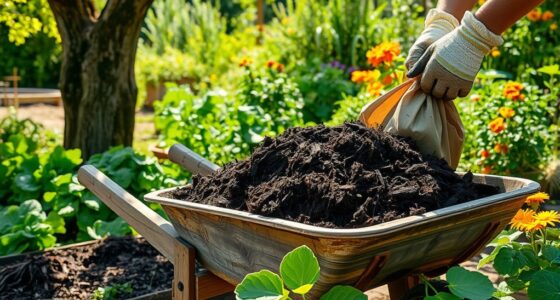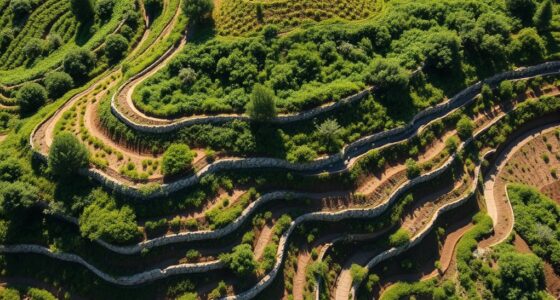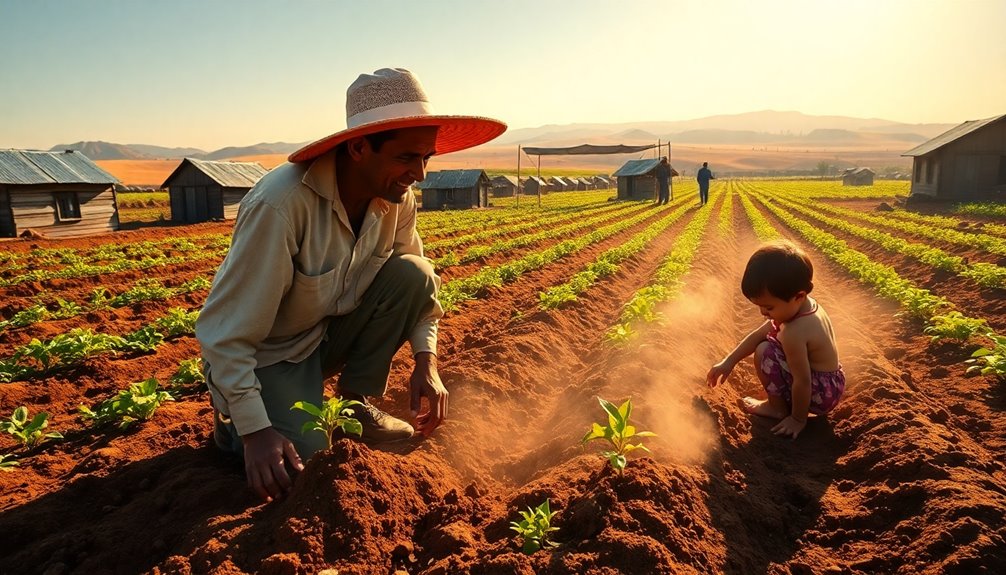Creating pollinator strips between your cash crops boosts productivity and supports ecosystem health. Choose native, climate-adapted plants that bloom at different times to provide continuous nectar and pollen. Position the strips along field edges or between crop sections to enhance connectivity and pollinator movement. Properly establish and regularly maintain these strips by managing weeds and ensuring soil health. To discover effective strategies for design, planting, and long-term management, keep exploring these valuable practices.
Key Takeaways
- Position pollinator strips along field edges or between crop sections to enhance habitat connectivity.
- Use native, diverse flowering plants that bloom at different times to ensure continuous nectar resources.
- Prepare soil properly, including erosion control and good drainage, for successful establishment of native plants.
- Incorporate cover crops during off-seasons to maintain soil health and prevent erosion around strips.
- Monitor and manage invasive weeds regularly, applying mulch and maintaining plant diversity for ecosystem resilience.
Benefits of Incorporating Pollinator Strips in Agriculture
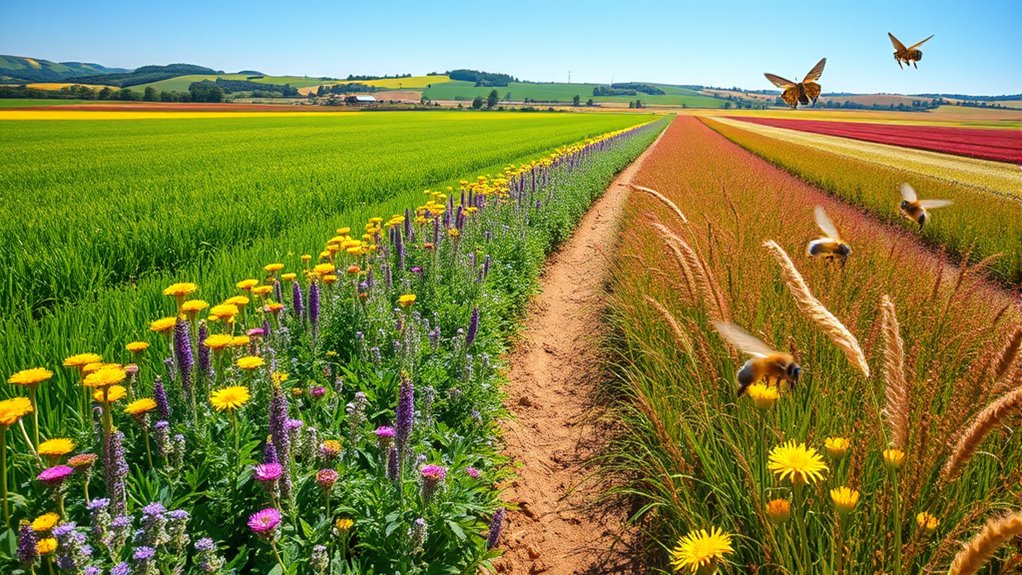
Incorporating pollinator strips into your agricultural landscape offers numerous benefits that can boost both crop productivity and ecosystem health. One key advantage is pest control, as the diverse pollinators and beneficial insects attracted to the strips help reduce pest populations naturally. This minimizes the need for chemical pesticides, supporting sustainable farming practices. Additionally, pollinator strips promote soil improvement by increasing organic matter and enhancing soil structure through plant diversity and root systems. These plants also aid in preventing erosion and improving water retention. Implementing cost-effective production methods for establishing these strips can make their integration more feasible for farmers. Moreover, selecting native plant species can enhance the adaptability and resilience of the pollinator strips in your local environment. As a result, your crops benefit from healthier soil and fewer pests, leading to higher yields and more resilient ecosystems. Strategic placement of pollinator-friendly plants can further enhance these benefits, ensuring a thriving and sustainable agricultural system. Overall, integrating pollinator strips creates a balanced environment that supports both crop growth and ecological stability.
Selecting Native Plants for Pollinator Strips
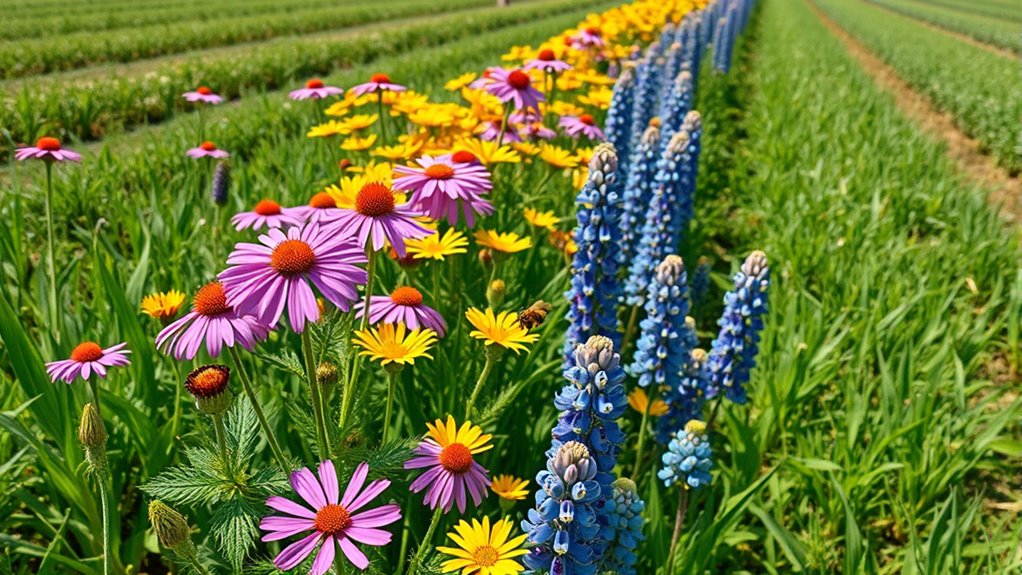
Choosing native plants for your pollinator strips offers benefits like better adaptation and supporting local ecosystems. When selecting, consider factors such as bloom timing, plant diversity, and growth habits to maximize pollinator activity. Ensuring seasonal bloom diversity keeps pollinators active year-round, enhancing crop pollination. Incorporating attractive flowering plants can further boost pollinator visitation rates and improve overall effectiveness. Additionally, selecting plants with diverse growth habits can create a more resilient and sustainable habitat for pollinators. Incorporating plants that are well-suited to your specific climate zone can also improve survival rates and the long-term success of your pollinator strips. Moreover, choosing plants that are native to your region supports local biodiversity and promotes a healthy, balanced ecosystem. Understanding the importance of native plant selection can help ensure the longevity and ecological benefits of your pollinator strips.
Native Plant Benefits
Selecting native plants for pollinator strips offers numerous benefits, as these species are well-adapted to your local environment and can thrive with minimal maintenance. They create a rich pollinator habitat, supporting bees, butterflies, and other beneficial insects. Native plant diversity ensures a variety of blooms throughout the season, providing continuous food sources for pollinators. This diversity attracts different species, increasing the resilience of your pollinator strip. Imagine a vibrant mosaic of plants: ecological stability and year-round bloom cycles that sustain local populations. This visual highlights how native plants fill the space year-round, maximizing pollinator support and ecological stability. Incorporating native plants also promotes biodiversity conservation, which is essential for healthy ecosystems. By choosing native species, you foster a sustainable environment that benefits both your crops and local biodiversity. Additionally, incorporating automation in agriculture can help manage and monitor your pollinator habitats more efficiently. Proper planning and native plant selection are key to creating a thriving pollinator strip.
Selection Criteria Tips
To make certain your pollinator strip thrives, it’s crucial to follow specific criteria when selecting native plants. Choose species that support beneficial insects involved in pest control, helping reduce pest populations naturally. Prioritize plants that improve soil health by fixing nitrogen or enhancing soil structure, which benefits your cash crops. Select plants adapted to your local climate and soil conditions to ensure resilience and low maintenance. Consider plants with diverse root systems to promote soil improvement and prevent erosion. Avoid invasive species that could outcompete native plants. Opt for a mix of species that provide continuous habitat and resources for pollinators throughout the season. Incorporating native plant diversity can further enhance the ecological benefits of your pollinator strip. Additionally, selecting plants with attractive blooms can attract a variety of pollinators, increasing the effectiveness of your strip. Choosing plants with drought tolerance can help reduce watering needs and ensure sustainability during dry periods. Using plants with resistance to pests can also minimize the need for chemical controls, promoting a healthier ecosystem. Integrating advanced materials in plant selection can boost the resilience and longevity of your pollinator strip, ensuring it remains productive over time. By focusing on pest control, soil enhancement, and adaptability, you create a sustainable, productive pollinator strip.
Seasonal Bloom Diversity
Incorporating a variety of blooms throughout the growing season guarantees your pollinator strip provides continuous resources for beneficial insects. Achieving seasonal bloom diversity ensures nectar and pollen are available from early spring to late fall, supporting a wide range of pollinators. Native plants that bloom at different times help maintain habitat connectivity, preventing gaps in nectar sources. This diversity also encourages a resilient ecosystem, attracting multiple beneficial insect species and promoting healthy pollinator populations. When selecting plants, choose species that flower at various intervals, creating a seamless flow of resources. Additionally, selecting vetted electric bike conversion kits can facilitate eco-friendly transportation for farm management tasks, reducing carbon footprint. Incorporating seasonal bloom diversity not only enhances the ecological value of your pollinator strip but also contributes to the overall sustainability of your farming practices. Using native plant species that are well-adapted to your local climate further supports thriving pollinator habitats. By emphasizing habitat connectivity, you strengthen habitat connectivity, making your pollinator strip a essential corridor for pollinators year-round. This approach maximizes ecological benefits and supports sustainable farming practices.
Designing Effective Layouts for Pollinator Habitats
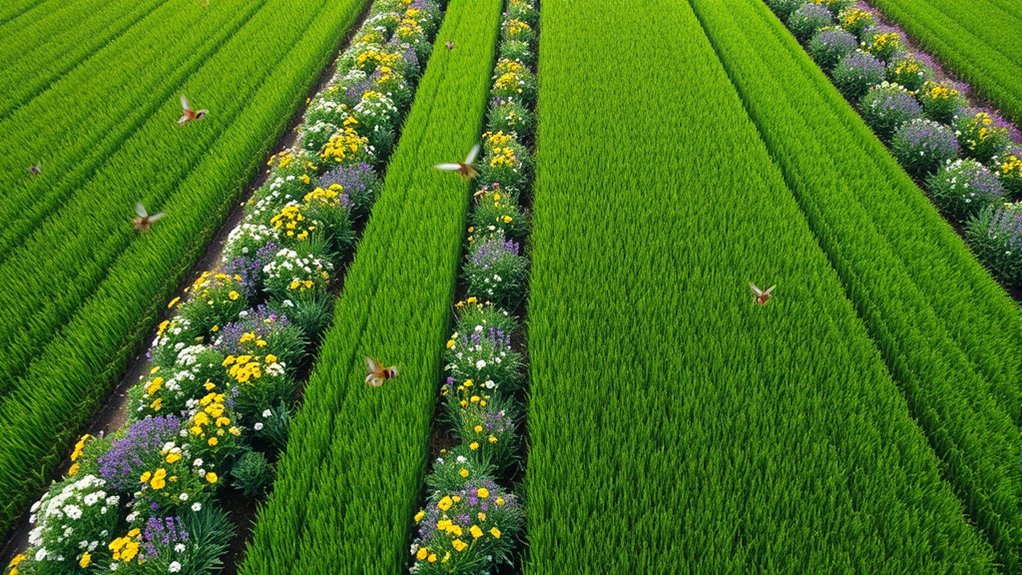
Designing effective layouts for pollinator habitats requires careful consideration of how the strips are positioned relative to crops. You want to maximize habitat connectivity, so pollinators can easily move between strips and crops, boosting pollination efficiency. Incorporate native plant diversity within your strips to attract a wide range of pollinators and support their life cycles. Position the strips strategically—placing them along field edges or between crop sections helps create corridors that improve habitat connectivity. Avoid clustering strips in one area, which can limit pollinator movement. Instead, spread them out to encourage diverse pollinator visitation across your fields. By paying attention to layout design, you enhance habitat quality, promote native plant diversity, and support sustainable crop production. Additionally, integrating Hyundai Tuning techniques like creating diverse and strategically placed habitat strips can further enhance pollinator activity and overall ecosystem health.
Planting and Establishing Pollinator Strips

To successfully create pollinator strips, you need to choose the right plant species that attract and support beneficial insects. Once you’ve selected your plants, focus on proper establishment and ongoing maintenance to guarantee they thrive. Consistent care will maximize the benefits these strips provide to both pollinators and your crops.
Selecting Suitable Plant Species
Choosing the right plant species is essential for establishing effective pollinator strips between cash crops. Selecting native or well-adapted plants encourages diverse pollinator activity, which can enhance pest control naturally and reduce the need for chemical interventions. Incorporate a mix of flowering plants that bloom at different times to provide continuous nectar and pollen sources. This diversity supports a broad range of pollinators, boosting crop yield and resilience. Avoid plants that may attract pests or compete aggressively with your cash crops. Instead, focus on species that complement your crop’s growth cycle and environmental conditions. Properly chosen plants create a balanced ecosystem, promoting healthy pollination and pest regulation, ultimately leading to more sustainable and productive farming systems.
Establishment and Maintenance Strategies
Establishing pollinator strips requires careful planning and timely execution to guarantee they become a thriving part of your farming system. You should prepare the soil properly, minimizing erosion and ensuring good drainage. Select native, resilient plants that attract pollinators and help with pest control naturally. To maintain soil health and prevent erosion, consider cover crops during off-seasons. Regularly monitor for invasive weeds that could threaten the strips’ success. Mulching helps retain moisture and suppress weeds.
| Soil Health | Pest Control | Erosion Prevention |
|---|---|---|
| Cover crops | Native plants | Mulching |
| Composting | Natural predators | Proper drainage |
| Mulching | Biological agents | Contour planting |
Managing and Maintaining Pollinator Strips for Long-Term Success
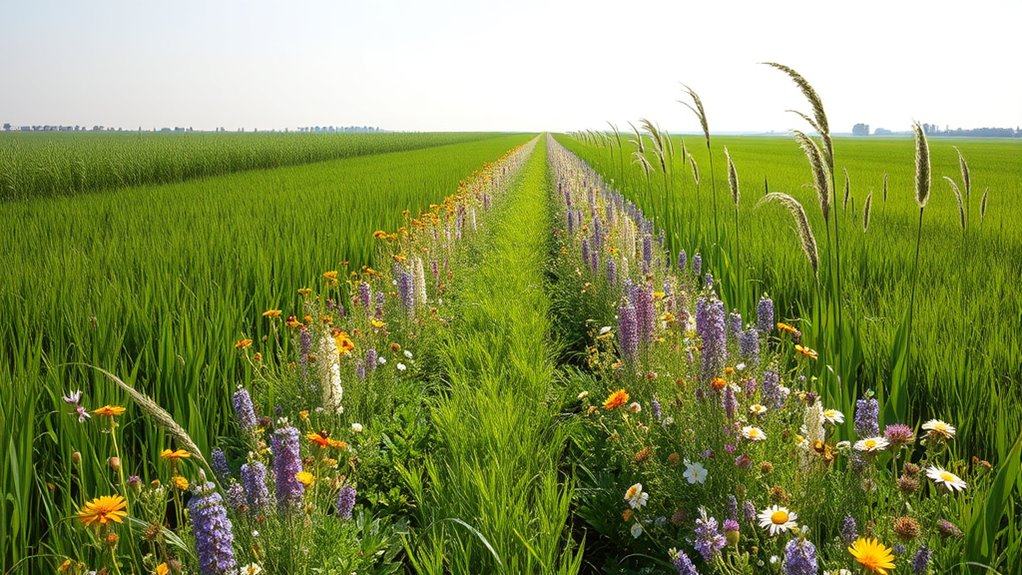
Maintaining pollinator strips over the long term requires regular attention and adaptive management. You should monitor for pests that may threaten both the strips and neighboring crops, implementing integrated pest management strategies to keep pest populations in check. Healthy soil is essential, so routinely assess soil health and add organic matter or nutrients as needed to promote robust plant growth. Avoid overuse of chemical pesticides that could harm pollinators, opting instead for targeted, eco-friendly solutions. Keep weeds under control to prevent competition and maintain plant diversity. Regularly inspect plant health and replace or diversify species if certain plants become invasive or decline. By staying proactive, you ensure your pollinator strips remain vibrant, beneficial, and sustainable for the long term.
Monitoring Impact and Enhancing Ecosystem Benefits

Monitoring the impact of your pollinator strips is essential to guarantee they deliver their intended benefits and support a healthy ecosystem. Regularly observe pest control levels to see if the strips attract beneficial insects that naturally suppress pests, reducing chemical use. Track soil health by checking for improvements in soil structure, nutrient levels, and moisture retention, which are often enhanced by diverse plant roots and organic matter. Use simple surveys or soil tests to gather data and identify changes over time. By consistently tracking these factors, you can make informed adjustments to your pollinator strips, increasing their effectiveness. This ongoing evaluation ensures your strips promote ecosystem benefits like balanced pest control and improved soil health, ultimately boosting crop productivity and sustainability.
Frequently Asked Questions
How Do Pollinator Strips Affect Overall Crop Yields?
Pollinator strips positively impact your crop yields by encouraging beneficial insect interactions, which help control pests naturally. They also promote soil health improvements, enriching nutrient levels and boosting plant growth. You might notice healthier plants and increased productivity as a result. By supporting pollinators and beneficial insects, you create a more balanced ecosystem that benefits your entire farming operation, ultimately leading to higher yields and sustainable crop management.
What Are the Initial Costs Involved in Establishing Pollinator Strips?
When you consider the initial costs involved, you’ll want to focus on cost estimation and budget planning. You’ll need funds for seed purchase, soil preparation, and possibly signage or fencing. The expenses vary based on strip size and plant selection. Planning carefully helps you manage costs effectively, ensuring you allocate enough budget for successful establishment without overspending. This proactive approach sets a strong foundation for your pollinator strips’ long-term benefits.
Are There Specific Pests or Diseases Associated With Pollinator Strips?
You might wonder if pollinator strips attract pests or spread diseases. While they can sometimes serve as pest attraction sites, proper management reduces this risk. Pollinator strips generally don’t cause disease transmission if maintained well, but poor sanitation could lead to issues. Regular monitoring and integrated pest management help prevent pests and diseases from affecting your cash crops, ensuring your system remains healthy and productive.
How Do Climate Variations Influence Pollinator Strip Effectiveness?
Climate variability dramatically impacts pollinator strip effectiveness, making or breaking your efforts to boost pollinator resilience. When temperatures swing wildly or rainfall becomes unpredictable, pollinators struggle to thrive, reducing their numbers and activity. This chaos can undermine your conservation goals, but understanding these effects helps you adapt strategies. By considering climate variability, you can design resilient pollinator strips that withstand weather fluctuations, ensuring healthier ecosystems and better crop yields.
Can Pollinator Strips Be Integrated With Organic Farming Practices?
You can definitely integrate pollinator strips with organic farming practices. They’re organic compatible because they enhance biodiversity without synthetic inputs, supporting natural pest management. By planting native flowers or flowering herbs, you attract beneficial insects that help control pests, reducing the need for chemical pesticides. This synergy boosts crop health and yields naturally, aligning perfectly with organic principles. Incorporating pollinator strips becomes a smart strategy for sustainable, eco-friendly pest management.
Conclusion
By adding pollinator strips between your cash crops, you support healthy ecosystems and boost yields. Imagine a farm where native wildflowers attract bees, leading to better pollination and larger harvests. For example, a small vegetable farm saw a 20% increase in fruit production after planting native pollinator strips. Start small, select the right plants, and watch your crops thrive while benefiting local pollinators. Taking these steps can transform your farm into a more sustainable and productive space.

